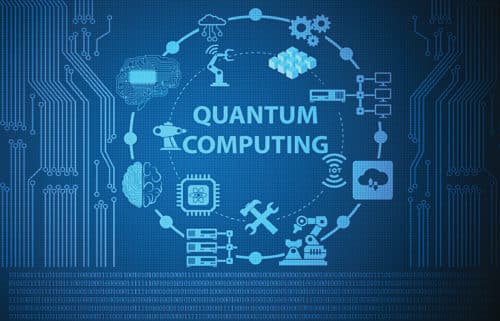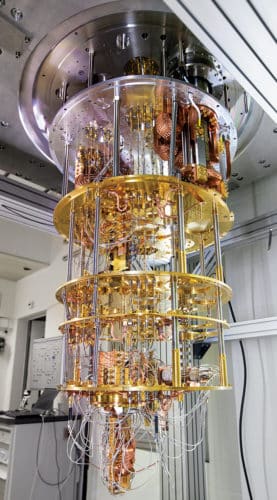Quantum computing helps scientists and researchers in solving problems above a certain complexity. Quantum computers derive their power by utilising quantum mechanics and marvels such as superposition and entanglement, which allows them to perform a variety of computational tasks exponentially faster than classical computers.

The invention of the computer has undeniably been one of the biggest technological revolutions in the history of mankind. However, classical computing is not the only way that was formulated in the last century to solve complex problems. While it was in 1927 that physicist Heisenberg introduced the uncertainty principle, it was not until 1970 that using quantum mechanics as a communication resource and the term quantum information theory came into being. So, the question arises: how is quantum computing different from classical computing, and how did it go from being a purely theoretical subject to being used by companies like Google and IBM?
Quantum computers versus classical computers
We already have computers and even supercomputers for faster processing speeds, then why do we need quantum computers? To understand it, we need to understand the difference between the two.
A classical computer’s main purpose is to save and manipulate data for working. Its chip uses bits to store this information. These bits are like tiny switches with two states—on and off, represented by one and zero, respectively. From every pixel in an image to the texts exchanged between people, everything is ultimately made up of these bits, a language that the computer understands. But even supercomputers cannot define the uncertain state that exists between on and off, especially on atomic and molecular levels. This makes them capable of only analysing simple molecules in practical applications related to biology and chemistry.
This is where scientists and researchers needed to find a better way of computing when the probability is involved (such as spinning a coin instead of flipping it). Also, for problems above a certain complexity, more computational power is required, which is only possible with quantum computers.
Dr Martin Laforest, senior product manager and quantum technology expert, Isara, explains, “Quantum computers leverage the surprising and often counterintuitive behaviour of atoms and molecules, making them radically different from today’s computer. They derive their power by utilising quantum mechanics and marvels such as superposition and entanglement. Their quantum behaviour makes them much more powerful, allowing them to perform a variety of computational tasks exponentially faster than classical computers.”
Behind the magic: Working of a quantum computer
Quantum computers use quantum bits (qubits) instead of the regular bits. By combining qubits, a lot more data can be processed in less time as compared to basic computers. Underlying quantum computing is the principle of quantum mechanics. Fundamental quantum properties like superposition, entanglement, and interference are used to manipulate the state of a qubit.
Superposition refers to the overlapping of usually independent states. Real-life examples include sounds generated while playing an instrument where notes are played simultaneously, or waves formed on throwing a stone in a lake. Qubits can be in superposition, that is, somewhere between on and off. This means that if there is more than one option, a quantum computer can go through each option simultaneously and choose the ultimate answer, instead of ruling out previous options individually before checking the next option.
Entanglement is a quantum phenomenon where states of two particles, even if they are physically separated, are tied such that they cannot be described independently of each other. Whatever is the result of measuring one of these particles, the outcome of another one will be mathematically related to it. This correlation is necessary for faster computations through special instructions (algorithms) that can only be written with quantum computers. Just like wave interference, quantum states can also change (cancel or add) depending on whether they are in phase or out of phase.

Making of a quantum computer
According to IBM researcher DiVincenzo’s Criteria, there are five minimal requirements for creating a quantum computer—a well-defined scalable qubit array; an ability to initialise the state of the qubits to a simple fiducial state; a universal set of quantum gates; long coherence times, much longer than the gate-operation time; and single-qubit measurement.
There are different ways to create a qubit. In one of the most commonly used methods, superconductivity is applied to create and preserve hard-to-maintain quantum states. Quantum computers are isolated from any sort of electrical interference and made to operate in an environment at almost absolute zero temperatures to prevent errors while working with qubits. Superconductors also minimise energy loss during transmission.
In order to achieve results close to absolute zero, necessary cooling power is made available and multiple other steps are followed. This includes attenuation during refrigeration to protect qubits from thermal noise during the process of transmitting signals to the quantum processor. Also, cryoperm shields protect the qubits from electromagnetic radiation.
To create a fault-tolerant quantum system, it is necessary to increase the computational power of a quantum computer. For this, higher numbers of qubits are preferable as states increase exponentially with each qubit. Researchers have designed algorithms for sequential quantum operations that can run on fault-tolerant quantum computers for extended periods of time. To ensure that the results are accurate and noise-free, low error rates need to be maintained.
New opportunities
Quantum computers are not just about saving time and money with better speed and higher efficiency of doing tasks that can already be performed. Quantum computers are thought to be useful in places where any uncertain system needs to be simulated.
Quantum chemistry is one of the most promising applications of quantum computing. By determining the lowest energy state among various molecular bond lengths that represents equilibrium molecular configuration, it is possible to simulate a molecule. Modeling even simple molecules and predicting particle interactions in chemical reactions can aid in discovery of new life-saving medicines and other compounds useful for making efficient devices, which is not possible with conventional computing memory and processing power.
Another application is cryptography, as these computers can easily generate hard-to-break encryption keys for better cyber security. Dr Laforest says, “Quantum computing promises many positive disruptions. One such possibility is the use of quantum particles called photons to create secure communications channels for the distribution of quantum keys. This has the potential to revolutionise networking and the protection of future data transmission.”
Other possibilities include improved solar panels, financial strategies for prediction of financial markets, better weather forecasts, and so on.
Problems encountered
Holding an object in a superposition state for a long period is difficult. Interaction with the environment is necessary for quantum measurement. But if a qubit comes in contact with such occurrences as changing magnetic and electric fields and radiation from warm objects nearby, or if there is a cross talk between qubits, it undergoes decoherence, and changes in the uncertain state cause the information to be lost. Due to these interference problems, in spite of high speeds, a quantum computer is also much more vulnerable to errors than a classical computer would be.
This requires robust quantum processes and designing devices such that the system is only sensitive to the targeted measurement, protecting quantum states from decoherence. But one needs to keep in mind that high sensitivity is crucial for precision.
When it comes to cybersecurity, Dr Laforest says, “It is important to note that quantum is a dual-use technology that also has the capacity to cause security chaos. Imagine a world where our existing encryption is no longer effective. If hackers equipped with quantum computers can break these algorithms, they can determine the private keys used to secure the data and expose it. The combination of quantum computer speed-ups and known algorithms developed by Peter Shor and Lov Grover make this possible. To ensure we are ready, preparation has to start now as it will take a decade or more to fix many of our complex systems. Experts in the field of quantum computer development agree it is highly probable we are only ten years away from large-scale quantum computing with this capability. Cybersecurity experts are already starting to prepare for potential quantum computer attacks on the encryption algorithms we use to protect data today.”
“The good news is that quantum-safe algorithms exist. The most significant challenge we face is the development of tools and methods that will make it easy and seamless to transition to these quantum-safe algorithms. Key to this success will be successfully completing this transition within a decade without any wholesale disruption to our current security systems and infrastructure,” Dr Laforest adds.
Dearth of required skill set, lack of available resources, and cost are some other impediments for it to be the technology in the making.
Can it be a staple technology?
Companies are competing to build reliable quantum computers in a variety of fields like manufacturing, security and financial services. Numerous startups like Isara, Ionq and 1qbit have come up in this field. They are willing to invest money in the technology at this early stage of development because of its great potential. Cloud based quantum computing technology is increasingly being leveraged to make it more easily available for remote access and be user-friendly for enterprises, no matter the size of their work teams. Microsoft in November 2019 announced that it would start providing access to quantum computers in its Azure cloud for select customers.
IBM Quantum designed and built the world’s first integrated quantum computing system ‘IBM Q System One’ for commercial use in 2019. Another company, D-Wave, recently announced that it is freely opening up its quantum computers to anyone who has ideas for how to use them to find a cure for COVID-19. For assistance in developing solutions, the company along with its customers like Cineca, Volkswagen, Denso, Tohoku University, Kyocera, Sigma-i, among others, is offering access to their engineering teams.
Quantum computers could change the world but they are still not advanced enough to replace the classical method. They are not so useful when it comes to the basic tasks like storing images that ordinary computers do. They are undoubtedly powerful, but not so reliable yet. As for now, the most beneficial way will be to give users access to both traditional and quantum computers simultaneously.






